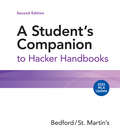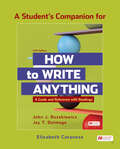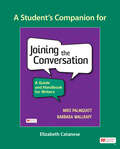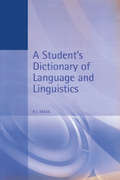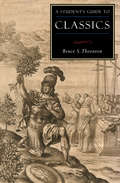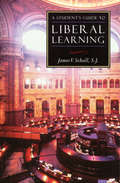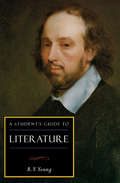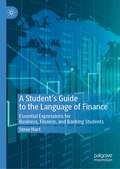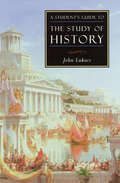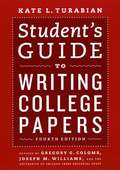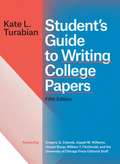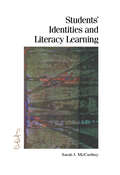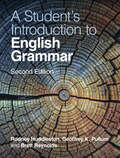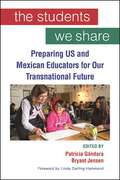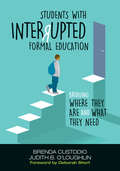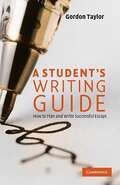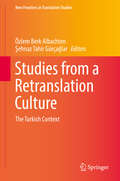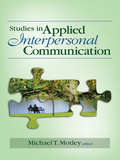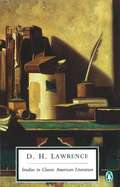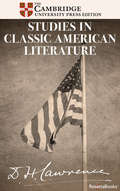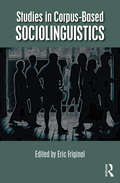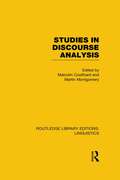- Table View
- List View
A Student's Companion to Hacker Handbooks with 2021 MLA Update
by Bedford/St.Martin'sThis ebook has been updated to provide you with the latest guidance on documenting sources in MLA style and follows the guidelines set forth in the MLA Handbook, 9th edition (April 2021).Writers develop over time. And the fact is, some writers need more time and more practice to develop the skills and habits that help them meet the challenges of the first-year writing course. For those students enrolled in paired, co-requisite, or ALP sections, A Student’s Companion to Hacker Handbooks offers practical support that will help them get up to speed and perform on-level.
A Student's Companion to How to Write Anything with Readings: A Guide and Reference
by Elizabeth Catanese John J. Ruszkiewicz Jay T. DolmageOffering practical support for students in corequisite composition courses (including ALP, support, labs, workshops, etc.), the Student’s Companion provides tips for student success, including advice about time management, academic planning, and test anxiety, as well as sentence strategies for academic writing. Available at no additional cost to students when packaged with How to Write Anything. Also available in Achieve.
A Student's Companion to Joining the Conversation: A Guide and Handbook for Writers
by Mike Palmquist Barbara Wallraff Elizabeth CataneseThe Student’s Companion supports students taking a co-requisite or ALP course alongside first-year composition. This workbook includes college success strategies; activities to help students develop their writing; and additional practice in correcting writing problems.
A Student's Dictionary of Language and Linguistics (Arnold Student Reference)
by Larry TraskThe terminology used in linguistics can be confusing for those encountering the subject for the first time. This dictionary provides accessible and authoritative explanations of the terms and concepts currently in use in all the major areas of language and linguistics, (pronunciation, word structure, sentence structure, meaning) as well as in the study of the social, anthropological, psychological and neurological aspects of language. Entries are clear and unambiguous, and helpful examples are used to clarify where appropriate. Particular attention is given to the terminology of traditional grammar. There are entries for the names of major language families, and there are also brief biographical entries for the major figures in the field, past and present. An extensive cross-referencing system makes the book easy to use: an invaluable annotated bibliography of texts on linguistics makes it an ideal guide for everyone beginning the study of language and linguistics.
A Student's Guide to Classics (ISI Guides to the Major Disciplines)
by Bruce S. ThorntonBruce Thornton's crisp and informative Student's Guide to Classics provides readers with an overview of each of the major poets, dramatists, philosophers, and historians of ancient Greece and Rome. Including short bios of major figures and a list of suggested readings, Thornton's guide is unparalleled as a brief introduction to the literature of the classical world.
A Student's Guide to Liberal Learning: Liberal Learning Guide (ISI Guides to the Major Disciplines)
by James V. SchallA Georgetown professor&’s look at the subjects one needs to study for a truly well-rounded education. A Student&’s Guide to Liberal Learning is an inviting conversation with a learned scholar about the content of an authentic liberal arts education. It surveys ideas and books central to the tradition of humanistic education that has fundamentally shaped our country and our civilization. This accessible volume argues for an order and integration of knowledge so that meaning might be restored to the haphazard approach to study currently dominating higher education. Freshly conveying the excitement of learning from the acknowledged masters of intellectual life, this guide is also an excellent blueprint for building one&’s own library of books that matter.
A Student's Guide to Literature: Literature Guide (ISI Guides to the Major Disciplines)
by R.V. YoungExplore the works of Western literature that have stood the test of time—and discover titles to enrich your own book collection.A Student&’s Guide to Literature takes up these questions: In a time of mass culture and pulp fiction, can great literature still be discerned, much less defended? Why is literature so compelling? What should we read? Literary scholar R. V. Young addresses these timely issues in this guide to Western literature and poetry. He demonstrates that literature liberates the mind from cultural and temporal provincialism by expanding our intellectual and emotional horizons. Learn how great fiction and poetry are integral to a liberal education, and visit the classic works of literature again—or for the first time.
A Student’s Guide to the Language of Finance: Essential Expressions for Business, Finance, and Banking Students
by Steve HartThis book focuses on improving reading comprehension by targeting the jargon, idiomatic language and academic expressions used in the business world. A Student’s Guide to the Language of Finance is a reference textbook designed to unlock the jargon of the business and finance world for international students, improving the reading comprehension and writing skill of English language learners by targeting the jargon, idiomatic language, and academic expressions employed in the business, finance, and banking fields. Covering terms not always captured in business dictionaries or workbooks, the resource also contains sections on spoken business English, key academic terms found in textbooks and journals and useful expressions to employ when writing an academic paper. It is specifically targeted at students whose first language is not English.
A Student's Guide to the Study of History (ISI Guides to the Major Disciplines #15)
by John LukacsA thoughtful look at the value of learning from the past: &“Nobody has done more than John Lukacs to turn the short history book into an art form&” (Antony Beevor, Toronto Globe & Mail). To study history is to learn about oneself. And to fail to grasp the importance of the past—to remain ignorant of the deeds and writing of previous generations—is to bind oneself by the passions and prejudices of the age into which one is born. John Lukacs, one of today&’s most widely published historians, explains what the study of history entails, how it has been approached over the centuries, and why it should be undertaken by today&’s students. This guide is an invitation to become a master of the historian&’s craft.
Student's Guide to Writing College Papers (4th edition)
by Kate L. Turabian Gregory G. Colomb Joseph M. WilliamsThis new edition is both a solid introduction to the research process and a convenient handbook to the best practices of writing college papers.
Student’s Guide to Writing College Papers, Fifth Edition: Fourth Edition (Chicago Guides to Writing, Editing, and Publishing)
by Kate L. TurabianStudents of all levels need to know how to write a well-reasoned, coherent research paper—and for decades Kate L. Turabian’s Student’s Guide to Writing College Papers has helped them to develop this critical skill. For its fifth edition, Chicago has reconceived and renewed this classic work for today’s generation. Addressing the same range of topics as Turabian’s A Manual for Writers of Research Papers, Theses, and Dissertations but for beginning writers and researchers, this guide introduces students to the art of formulating an effective argument, conducting high-quality research with limited resources, and writing an engaging class paper. This new edition includes fresh examples of research topics, clarified terminology, more illustrations, and new information about using online sources and citation software. It features updated citation guidelines for Chicago, MLA, and APA styles, aligning with the latest editions of these popular style manuals. It emphasizes argument, research, and writing as extensions of activities that students already do in their everyday lives. It also includes a more expansive view of what the end product of research might be, showing that knowledge can be presented in more ways than on a printed page. Friendly and authoritative, the fifth edition of Student’s Guide to Writing College Papers combines decades of expert advice with new revisions based on feedback from students and teachers. Time-tested and teacher-approved, this book will prepare students to be better critical thinkers and help them develop a sense of inquiry that will serve them well beyond the classroom.
Students' Identities and Literacy Learning: Students' Identities And Literacy Learning (IRA's Literacy Studies Series)
by Sarah J. McCarthey IraEducators will find in this book an opportunity to examine the multiple, dynamic identities of the students they instruct and to consider the ways in which all teachers and students are shaped by their social and cultural settings. The volume is the first to examine theories of identity and elementary literacy practices by presenting data in a teacher-friendly format. The chapters highlight the influences of school and, to some extent, home contexts on students' identities as readers and writers, and give numerous implications for practice. McCarthey collected data from three sites in which teachers implemented writing workshop and literature-based instruction in grades 3-6. This book focuses on the students in these sites, who were from diverse cultural and social backgrounds. By providing information about the contexts in which students read and wrote, McCarthey demonstrates the power of the teacher-student relationship, the importance of the classroom curriculum, and the influence of parents and peers on students. Published by International Reading Association
A Student's Introduction to English Grammar
by Rodney Huddleston Geoffrey K. Pullum Brett ReynoldsA new edition of a successful undergraduate textbook on contemporary international Standard English grammar, based on Huddleston and Pullum's earlier award-winning work, The Cambridge Grammar of the English Language (2002). The analyses defended there are outlined here more briefly, in an engagingly accessible and informal style. Errors of the older tradition of English grammar are noted and corrected, and the excesses of prescriptive usage manuals are firmly rebutted in specially highlighted notes that explain what older authorities have called 'incorrect' and show why those authorities are mistaken. Intended for students in colleges or universities who have little or no background in grammar or linguistics, this teaching resource contains numerous exercises and online resources suitable for any course on the structure of English in either linguistics or English departments. A thoroughly modern undergraduate textbook, rewritten in an easy-to-read conversational style with a minimum of technical and theoretical terminology.
A Student's Introduction to English Grammar
by Geoffrey K. Pullum Rodney HuddlestonThis groundbreaking undergraduate textbook on modern Standard English grammar is the first to be based on the revolutionary advances of the authors' previous work, The Cambridge Grammar of the English Language (2002). The analyses defended there are outlined here more briefly, in an engagingly accessible and informal style. Errors of the older tradition of English grammar are noted and corrected, and the excesses of prescriptive usage manuals are firmly rebutted in specially highlighted notes that explain what older authorities have called 'incorrect' and show why those authorities are mistaken. This book is intended for students in colleges or universities who have little or no previous background in grammar, and presupposes no linguistics. It contains exercises, and will provide a basis for introductions to grammar and courses on the structure of English not only in linguistics departments but also in English language and literature departments and schools of education.
The Students We Share: Preparing US and Mexican Educators for Our Transnational Future
by Patricia Gándara; Bryant JensenMillions of students in the US and Mexico begin their educations in one country and find themselves trying to integrate into the school system of the other. As global migration increases, their numbers are expected to grow and more and more teachers will find these transnational students in their classrooms. The goal of The Students We Share is to prepare educators for this present and future reality. While the US has been developing English as a Second Language programs for decades, Mexican schools do not offer such programs in Spanish and neither the US nor Mexico has prepared its teachers to address the educational, social-psychological, or other personal needs of transnational students. Teachers know little about the circumstances of transnational students' lives or histories and have little to no knowledge of the school systems of the country from which they or their family come. As such, they are fundamentally unprepared to equitably educate the "students we share," who often fall through the cracks and end their educations prematurely. Written by both Mexican and US pioneers in the field, chapters in this volume aim to prepare educators on both sides of the US-Mexico border to better understand the circumstances, strengths, and needs of the transnational students we teach. With recommendations for policymakers, administrators, teacher educators, teachers, and researchers in both countries, The Students We Share shows how preparing teachers is our shared responsibility and opportunity. It describes policies, classroom practices, and norms of both systems, as well as examples of ongoing partnerships across borders to prepare the teachers we need for our shared students to thrive.
Students With Interrupted Formal Education: Bridging Where They Are and What They Need
by Brenda K. Custodio Judith B. O'LoughlinNew hope for our most vulnerable English learners “One of the guiding principles of effective English language teaching is for educators to know their students. And that in a nutshell captures the value of this book. . . . The compassion that Custodio and O’Loughlin feel for our SIFE students, the commitment they have to educating them well, and the comprehension they have of the assets these learners bring to the classroom are evident in the writing, tools, and vignettes they share.” -Deborah J. Short Under the best of circumstances, the academic demands of today’s classrooms can be daunting to our English learners. But for the tens of thousands of newly arrived students with interrupted formal education, even the social challenges can be outright overwhelming. Rely on this all-in-one guide from Brenda Custodio and Judith O’Loughlin for expert insight on how to build the skills these students need for success in school and beyond. Inside you’ll find Essential background on factors leading to interrupted education Specific focus on refugee children and Latino immigrants Guidance on building internal resilience for long-term social and emotional health Recommendations for creating supportive environments at the classroom, school, and district level About one thing, Brenda and Judith are absolutely convinced: our SIFE students can learn and make progress, often at a remarkable speed. But it’s up to us, their educators, to provide the time, attention, and a specific focus. Consider this book your first step forward.
Students With Interrupted Formal Education: Bridging Where They Are and What They Need
by Brenda K. Custodio Judith B. O'LoughlinNew hope for our most vulnerable English learners “One of the guiding principles of effective English language teaching is for educators to know their students. And that in a nutshell captures the value of this book. . . . The compassion that Custodio and O’Loughlin feel for our SIFE students, the commitment they have to educating them well, and the comprehension they have of the assets these learners bring to the classroom are evident in the writing, tools, and vignettes they share.” -Deborah J. Short Under the best of circumstances, the academic demands of today’s classrooms can be daunting to our English learners. But for the tens of thousands of newly arrived students with interrupted formal education, even the social challenges can be outright overwhelming. Rely on this all-in-one guide from Brenda Custodio and Judith O’Loughlin for expert insight on how to build the skills these students need for success in school and beyond. Inside you’ll find Essential background on factors leading to interrupted education Specific focus on refugee children and Latino immigrants Guidance on building internal resilience for long-term social and emotional health Recommendations for creating supportive environments at the classroom, school, and district level About one thing, Brenda and Judith are absolutely convinced: our SIFE students can learn and make progress, often at a remarkable speed. But it’s up to us, their educators, to provide the time, attention, and a specific focus. Consider this book your first step forward.
A Student's Writing Guide: How to Plan and Write Successful Essays
by Gordon TaylorAre you struggling to meet your coursework deadlines? Finding it hard to get to grips with your essay topics? Does your writing sometimes lack structure and style? Would you like to improve your grades? This text covers everything a student needs to know about writing essays and papers in the humanities and social sciences. Starting from the common difficulties students face, it gives practical examples of all the stages necessary to produce a good piece of academic work: - interpreting assignment topics - drawing on your own experience and background - reading analytically and taking efficient notes - developing your argument through introductions, middles and conclusions - evaluating and using online resources - understanding the conventions of academic culture - honing your ideas into clear, vigorous English. This book will provide you with all the tools and insights you need to write confident, convincing essays and coursework papers.
Studies from a Retranslation Culture: The Turkish Context (New Frontiers in Translation Studies)
by Özlem Berk Albachten Şehnaz Tahir GürçağlarThis book highlights the unique history and cultural context of retranslation in Turkey, offering readers a survey of the diverse range of fields, disciplines, and genres in which retranslation has assumed a central position. Further, it addresses largely unexplored issues such as retranslation in Ottoman literature, paratextual positioning and marketing of retranslations, legal retranslation, and retranslation in music. As such, it makes a valuable contribution to the growing body of research on retranslation by placing special emphasis on non-literary translation, making the role of retranslation particularly visible in connection with politics and philosophy in Turkey.
Studies in Applied Interpersonal Communication
by Michael T. MotleyStudies in Applied Interpersonal Communication offers solutions for communication problems that erupt in our daily lives. By focusing on socially meaningful applied research in communication, this book offers a new direction for interpersonal communication studies. Featuring original studies that are practical and relevant, chapters provide readers with a balanced combination of rigorous research with pragmatic application. This book will generate enthusiasm among students and scholars and inspire future research that moves beyond the theoretical and toward the practical.
Studies in Classic American Literature
by D. H. LawrenceLawrence asserted that 'the proper function of a critic is to save the tale from the artist who created it'. In these highly individual, penetrating essays he has exposed 'the American whole soul' within some of that continent's major works of literature. In seeking to establish the status of writings by such authors as Poe, Melville, Fenimore Cooper and Whitman, Lawrence himself has created a classic work. Studies in Classic American Literature is valuable not only for the light it sheds on eighteenth- and nineteenth-century American consciousness, telling 'the truth of the day', but also as a prime example of Lawrence's learning, passion and integrity of judgement.
Studies in Classic American Literature (Classic, 20th-century, Penguin Ser.)
by D.H. LawrenceThe author of such classics as Sons and Lovers and The Rainbow critically examines classic American literature in this collection of essays. This anthology provides a deep look at D. H. Lawrence&’s thoughts on American literature, including notable essays on Benjamin Franklin, Edgar Allan Poe, Nathaniel Hawthorne, Herman Melville, and Walt Whitman. Originally published in 1923, this volume has corrected and uncensored the text, and presents earlier versions of many of the essays.
Studies in Corpus-Based Sociolinguistics
by Eric FriginalStudies in Corpus-Based Sociolinguistics illustrates how sociolinguistic approaches and linguistic distributions from corpora can be effectively combined to produce meaningful studies of language use and language variation. Three major parts comprise the volume focusing on: (1) Corpora and the Study of Languages and Dialects, in particular, varieties of global Englishes; (2) Corpora and Social Demographics; and (3) Corpora and Register Characteristics. The 14 peer-reviewed, new, and original chapters explore language variation related to regional dialectology, gender, sexuality, age, race, ‘nation,’ workplace discourse, diachronic change, and social media and web registers. Invited contributors made use of systematically-designed general and specialized corpora, sound research questions, methodologies (e.g., keyword analysis, multi-dimensional analysis, clusters, and collocations), and logical/credible interpretive techniques. Studies in Corpus-Based Sociolinguistics is an important resource for researchers and graduate students in the fields of sociolinguistics, corpus linguistics, and applied linguistics.
Studies in Discourse Analysis: Linguistics: Studies In Discourse Analysis (Routledge Library Editions: Linguistics)
by Malcolm Coulthard Martin MontgomeryThe book explores ways in which the formal methods of linguistics can cast light on the structure of verbal interaction, and in particular considers how successive utterances cohere together in continuous spoken discourse. Beginning with an earlier model of discourse analysis elaborated to deal with teacher-pupil interaction in the classroom, it then reviews attempts to extend this model to a variety of discourses such as committee talk, doctor-patient interviews, broadcast discussions and the monologue of lectures. The extension of the original model to other situations has prompted a number of innovations and additional insights which are expounded in a series of contributions linked by complimentary themes. There are contributions on the role of intonation and of kinetics in discourse analysis; explorations of the problems of the analytic category ‘sentence’ and of the problems raised by casual conversation; and there is extended discussion of the structural properties underlying exchanges of utterances. The book moves easily between data and theory, forming a unified whole. It sums up a continuing and lively debate within a common tradition of discourse analysis and may well serve as a programmatic statement for future work in the field.
Studies in English Language: Grammatical Complexity in Academic English
by Biber, Douglas and Gray, Bethany Douglas Biber Bethany GrayGrammatical Complexity in Academic English uses corpus-based analyses to challenge a number of dominant stereotypes and assumptions within linguistics. Biber and Gray tackle the nature of grammatical complexity, demonstrating that embedded phrasal structures are as important as embedded dependent clauses. The authors also overturn ingrained assumptions about linguistic change, showing that grammatical change occurs in writing as well as speech. This work establishes that academic writing is structurally compressed (rather than elaborated); that it is often not explicit in the expression of meaning; and that scientific academic writing has been the locus of some of the most important grammatical changes in English over the past 200 years (rather than being conservative and resistant to change). Supported throughout with textual evidence, this work is essential reading for discourse analysts, sociolinguists, applied linguists, as well as descriptive linguists and historical linguists.
